German space programme
The German space programme is the set of projects funded by the government of Germany for the exploration and utilisation of outer space. The space programme is run by the German Aerospace Center, who conduct research, plan, and implement the programme on behalf of the German federal government.
History
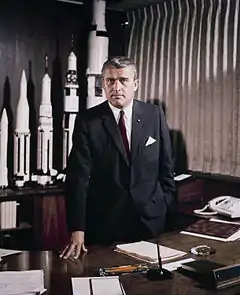
Between 1930s and 1940s, Nazi Germany researched and built operational ballistic missiles capable of suborbital spaceflight.[1] Starting in the early 1930s, during the last stages of the Weimar Republic, German aerospace engineers experimented with liquid-fueled rockets, with the goal that one day they would be capable of reaching high altitudes and traversing long distances.[2] The head of the German Army's Ballistics and Munitions Branch, Lieutenant Colonel Karl Emil Becker, gathered a small team of engineers that included Walter Dornberger and Leo Zanssen, to figure out how to use rockets as long-range artillery in order to get around the Treaty of Versailles' ban on research and development of long-range cannons.[3] Wernher von Braun, a young engineering prodigy, was recruited by Becker and Dornberger to join their secret army programme at Kummersdorf-West in 1932.[4] Von Braun dreamed of conquering outer space with rockets and did not initially see the military value in missile technology.[5]
During the Second World War, General Dornberger was the military head of the army's rocket programme, Zanssen became the commandant of the Peenemünde army rocket centre, and von Braun was the technical director of the ballistic missile programme.[6] They led the team that built the Aggregat-4 (A-4) rocket, which became the first vehicle to reach outer space during its test flight programme in 1942 and 1943.[7] By 1943, Germany began mass-producing the A-4 as the Vergeltungswaffe 2 ("Vengeance Weapon" 2, or more commonly, V2), a ballistic missile with a 320 kilometers (200 mi) range carrying a 1,130 kilograms (2,490 lb) warhead at 4,000 kilometers per hour (2,500 mph).[8] Its supersonic speed meant there was no defence against it, and radar detection provided little warning.[9] Germany used the weapon to bombard southern England and parts of Allied-liberated western Europe from 1944 until 1945.[10] After the war, the V-2 became the basis of early American and Soviet rocket designs.[11][12]
At war's end, American, British, and Soviet scientific intelligence teams competed to capture Germany's rocket engineers along with the German rockets themselves and the designs on which they were based.[13] Each of the Allies captured a share of the available members of the German rocket team, but the United States benefited the most with Operation Paperclip, recruiting von Braun and most of his engineering team, who later helped develop the American missile and space exploration programmes. The United States also acquired a large number of complete V2 rockets.[11]
Organisations

German Aerospace Center
The German Aerospace Center (German: Deutsches Zentrum für Luft- und Raumfahrt e.V., literally German Center for Air- and Space-flight), abbreviated DLR, is the national center for aerospace, energy and transportation research of Germany. Its headquarters are located in Cologne and it has multiple other locations throughout Germany. The DLR is engaged in a wide range of research and development projects in national and international partnerships. In addition to conducting its own research projects, DLR also acts as the German space agency. As such, it is responsible for planning and implementing the German space programme on behalf of the German federal government. As a project management agency, DLR also coordinates and answers the technical and organisational implementation of projects funded by a number of German federal ministries.
The German Aerospace Center has a national budget of €3.816 billion.[14]Institute of Space Propulsion
The Institute of Space Propulsion in Lampoldshausen is one of the eight research centers of the German Aerospace Center (DLR).
Approximately 220 people work there in the fields of research and tests of rocket engines. The main purpose of the facility is the operation of test stands for space propulsion on behalf of the European Space Agency (ESA) and in cooperation with the European space industry.Mission control centres
Columbus Control Centre
.jpg.webp)
The Columbus Control Centre also known by its radio callsign, Mission Control Munich, is the mission control centre which is used to control the Columbus research laboratory, which is part of the International Space Station (ISS). The control centre is located at the German Aerospace Center (DLR) facility in Oberpfaffenhofen near Munich, Germany. The centre is operated by the DLR, under contract from the European Space Agency (ESA).
The Columbus Control Centre entered full-time operation during the STS-122 Shuttle Mission, which delivered the Columbus module to the ISS. The module was attached to the ISS on 11 February 2008.European Space Operations Centre
The European Space Operations Centre (ESOC) serves as the main mission control centre for the European Space Agency (ESA) and is located in Darmstadt, Germany. ESOC's primary function is the operation of unmanned spacecraft on behalf of ESA and the launch and early orbit phases (LEOP) of ESA and third-party missions.[15] The Centre is also responsible for a range of operations-related activities within ESA and in cooperation with ESA's industry and international partners, including ground systems engineering, software development, flight dynamics and navigation, development of mission control tools and techniques and space debris studies.[16]
ESOC's current major activities comprise operating planetary and solar missions, such as Mars Express and the Trace Gas Orbiter, astronomy & fundamental physics missions, such as Gaia (spacecraft) and XMM Newton, and Earth observation missions such as CryoSat2 and Swarm (spacecraft).
ESOC is responsible for developing, operating and maintaining ESA's ESTRACK network of ground stations. Teams at the Centre are also involved in research and development related to advanced mission control concepts and Space Situational Awareness, and standardisation activities related to frequency management; mission operations; tracking, telemetry and telecommanding; and space debris.[17]German Space Operations Center
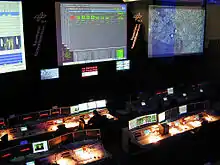
After the Federal Republic of Germany decided in the 1960s to launch a national space program and to participate in international space projects, the idea of having its own space control center became concrete. In 1967, then Federal Minister of Finance Franz Josef Strauss laid the foundation stone for the first building complex, which was also opened a little later.
Until 1985, the Oberpfaffenhofen site of the then German Aerospace Research and Testing Institute (DFVLR) increasingly concentrated on spaceflight. The human spaceflight received special attention. Indeed, the GSOC then accompanied two crewed missions: During STS-61-A in 1985, GSOC took over the control of the Spacelab, while flight control continued from NASA's Lyndon B. Johnson Space Center was acquired. For the first time, the Payload Operation Control Center (POCC) of a US space mission was directed outside of NASA. This also means that, for the first time, a human spaceflight was (partially) monitored from outside the USA or the Soviet Union.[18] During this mission, then Bavarian Prime Minister Franz Josef Strauss announced on 5 November 1985 an extensive investment program with which the role of Oberpfaffenhofen in European spaceflight should be increased.
But the failure of Ariane 3 in 1985 and the Challenger disaster in 1986 slowed the development of the Oberpfaffenhofen and thus the GSOC. Nevertheless, the investment program also gave the GSOC a new building (Building 140), the construction began on 4 April 1989.
In 1993, GSOC accompanied the entire operation with STS-55 and had full payload control via the Spacelab. This was the first time that there was unfiltered access to all data.Astronauts
As of 2018, eleven Germans have been in space. The first German, and only East German, in space was Sigmund Jähn in 1978. Three astronauts – Ulf Merbold, Reinhard Furrer and Ernst Messerschmid – represented West Germany during the time of divided Germany. Merbold made two other spaceflights after Germany was reunified in 1990; thus, he is the only German to have been in space three times. Thomas Reiter and Alexander Gerst are the only Germans to have made long-term spaceflights. The other five astronauts are Klaus-Dietrich Flade, Hans Schlegel, Ulrich Walter, Reinhold Ewald, and Gerhard Thiele.
Rockets
V-2
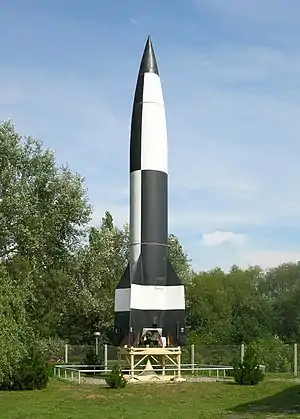
The V-2 (German: Vergeltungswaffe 2, "Retribution Weapon 2"), with the technical name Aggregat 4 (A4), was the world's first missile or long-range[19] guided ballistic missile. The missile, powered by a liquid-propellant rocket engine, was developed during the Second World War in Germany as a "vengeance weapon" and assigned to attack Allied cities as retaliation for the Allied bombings against German cities. The V-2 rocket also became the first artificial object to travel into space by crossing the Kármán line with the vertical launch of MW 18014 on 20 June 1944.[20]
Research into military use of long-range rockets began when the graduate studies of Wernher von Braun attracted the attention of the German Army. A series of prototypes culminated in the A-4, which went to war as the V-2. Beginning in September 1944, over 3,000 V-2s were launched by the German Wehrmacht against Allied targets, first London and later Antwerp and Liège. According to a 2011 BBC documentary,[21] the attacks from V-2s resulted in the deaths of an estimated 9,000 civilians and military personnel, and a further 12,000 forced laborers and concentration camp prisoners died as a result of their forced participation in the production of the weapons.[22]
The rockets travelled at supersonic speed, impacted without audible warning, and proved unstoppable, as no effective defence existed. Teams from the Allied forces—the United States, the United Kingdom, and the Soviet Union—raced to seize key German manufacturing facilities, procure Germany's missile technology, and capture the V-2's launching sites. Von Braun and over 100 key V-2 personnel surrendered to the Americans, and many of the original V-2 team ended up working at the Redstone Arsenal. The US also captured enough V-2 hardware to build approximately 80 of the missiles. The Soviets gained possession of the V-2 manufacturing facilities after the war, re-established V-2 production, and moved it to the Soviet Union.TEXUS
TEXUS is a European/German sounding rocket programme, serving the microgravity programmes of ESA and DLR. The launches are conducted from Esrange in Sweden.
The first mission was conducted on 13 December 1977, using a British Skylark rocket. All missions up to TEXUS-41 in 2004 were conducted using Skylark rockets. Following the Skylark's retirement in 2005, TEXUS launches switched to the Brazilian VSB-30 rocket.Liquid fly-back booster
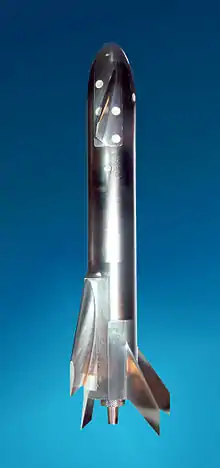
Liquid Fly-back Booster (LFBB) was a German Aerospace Center's (DLR's) project concept to develop a liquid rocket booster capable of reusing for Ariane 5 in order to significantly reduce the high cost of space transportation and increase environmental friendliness.[23] LFBB would replace the existing solid rocket boosters, providing main thrust during the liftoff. Once separated, two winged boosters would perform an atmospheric entry, fly back autonomously to the French Guiana, and land horizontally on the airport like an aeroplane.
Additionally a family of derivative launch vehicles was proposed in order to take an advantage of economies of scale, further reducing launch costs. These derivatives include:
German Aerospace Center studied Liquid Fly-back Boosters as a part of future launcher research programme from 1999 to 2004.[24] After the cancellation of the project, publications at DLR continued until 2009.SpaceLiner
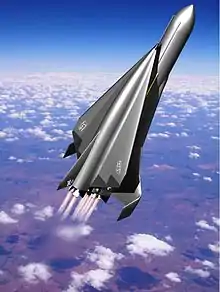
SpaceLiner is a concept for a suborbital, hypersonic, winged passenger supersonic transport, conceived at the German Aerospace Center (Deutsches Zentrum für Luft- und Raumfahrt, or DLR) in 2005.[25] In its second role the SpaceLiner is intended as a reusable launch vehicle (RLV) capable of delivering heavy payloads into orbit.[26]
The SpaceLiner is a very long-term project, and does not currently have funding lined up to initiate system development as of 2017. Projections in 2015 were that if adequate funding was eventually secured, the SpaceLiner concept might become an operational spaceplane in the 2040s.[27][26]RETALT
RETALT (RETro Propulsion Assisted Landing Technologies) is a project for aiming to investigate in key technologies for retropropulsion reusable launch systems established in March 2019 with funds from the European Union's Horizon 2020 program. It aims to "advance the research and development of key technologies for European vertical-landing launch vehicles."[28][29][30]
The reference configurations for the development of the targeted technologies are two types of vertical launch and landing rockets a two-stage-to-orbit and a single-stage to orbit .[31][32][33] The partner organisations are DLR, CFS Engineering (Switzerland), Elecnor Deimos (Spain), MT Aerospace (Germany), Almatech (Switzerland) and Amorim Cork Composites (Portugal).[34][35][36][37][38]Missions operated by Germany
MW 18014
Helios
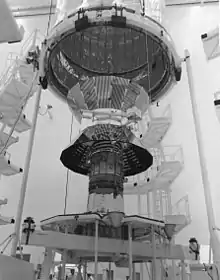
Helios-A and Helios-B (also known as Helios 1 and Helios 2) are a pair of probes that were launched into heliocentric orbit to study solar processes. As a joint venture of West Germany's space agency DLR (70 percent share) and NASA (30 percent share) the probes were launched from Cape Canaveral Air Force Station, Florida, on December 10, 1974, and January 15, 1976, respectively. As built by the main contractor, Messerschmitt-Bölkow-Blohm, they were the first space probes built outside the United States and the Soviet Union to leave Earth's orbit.
The probes set a maximum speed record for spacecraft of 252,792 km/h (157,078 mph; 70,220 m/s).[43] Helios-B flew 3,000,000 kilometres (1,900,000 mi) closer to the Sun than Helios-A, achieving perihelion on April 17, 1976, at a record distance of 43.432 million km (26,987,000 mi; 0.29032 AU),[44] closer than the orbit of Mercury. Helios-B was sent into orbit 13 months after the launch of Helios-A. The Helios space probes completed their primary missions by the early 1980s but continued to send data up to 1985.
The probes are no longer functional yet remain in their elliptical orbits around the Sun.[45][46][47][48]STS-61-A
STS-61-A (formerly STS-30 & also known as D-1) was the 22nd mission of NASA's Space Shuttle program. It was a scientific Spacelab mission, funded and directed by West Germany – hence the non-NASA designation of D-1 (for Deutschland-1). STS-61-A was the ninth and last successful flight of Space Shuttle Challenger. STS-61-A holds the current record for the largest crew - eight people - aboard any single spacecraft for the entire period from launch to landing.
The mission carried the NASA/ESA Spacelab module into orbit with 76 scientific experiments on board, and was declared a success.[49] Payload operations were controlled from the German Space Operations Center in Oberpfaffenhofen, West Germany, instead of from the regular NASA control centers.[50]STS-55
SAMPEX
The Solar Anomalous and Magnetospheric Particle Explorer (SAMPEX) was a NASA solar and magnetospheric observatory, and was the first spacecraft in the Small Explorer program. It was launched into low Earth orbit on July 3, 1992, from Vandenberg Air Force Base aboard a Scout G-1 rocket. SAMPEX was an international collaboration between NASA of the United States and the Max Planck Institute for Extraterrestrial Physics of Germany.[51]
The spacecraft carried four instruments designed to measure the anomalous components of cosmic rays, emissions from solar energetic particles, and electron counts in Earth's magnetosphere. Built for a three-year mission, its science mission was ended on June 30, 2004.[52] Mission control for SAMPEX was handled by the Goddard Space Flight Center until October 1997, after which it was turned over to the Bowie State University Satellite Operations Control Center (BSOCC).[53] BSOCC, with funding assistance from The Aerospace Corporation, continued to operate the spacecraft after its science mission ended, using the spacecraft as an educational tool for its students while continuing to release science data to the public.[54][55]
Built for a three-year primary mission, the spacecraft continued to return science data until its reentry on November 13, 2012.[54][56]ABRIXAS
A Broadband Imaging X-ray All-sky Survey, or ABRIXAS was a space-based German X-ray telescope. It was launched on 28 April 1999 in a Kosmos-3M launch vehicle from Kapustin Yar, Russia, into Earth orbit. The orbit had a periapsis of 549.0 kilometres (341.1 mi), an apoapsis of 598.0 kilometres (371.6 mi), an inclination of 48.0° and an eccentricity of 0.00352, giving it a period of 96 minutes.[57][58]
The telescope's battery was accidentally overcharged and destroyed three days after the mission started. When attempts to communicate with the satellite when its solar panels were illuminated by sunlight failed, the $20 million project was abandoned.[59] ABRIXAS decayed from orbit on 31 October 2017.
The eROSITA telescope is based on the design of the ABRIXAS observatory.[60] eROSITA was launched on board the Spektr-RG space observatory on 13 July 2019 from Baikonur to be deployed at the second Lagrange point (L2).[61]DLR-Tubsat
TerraSAR-X
Columbus
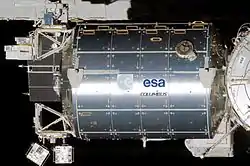
Columbus is a science laboratory that is part of the International Space Station (ISS) and is the largest single contribution to the ISS made by the European Space Agency (ESA).
Like the Harmony and Tranquility modules, the Columbus laboratory was constructed in Turin, Italy by Thales Alenia Space. The functional equipment and software of the lab was designed by EADS in Bremen, Germany. It was also integrated in Bremen before being flown to the Kennedy Space Center (KSC) in Florida in an Airbus Beluga. It was launched aboard Space Shuttle Atlantis on February 7, 2008 on flight STS-122. It is designed for ten years of operation. The module is controlled by the Columbus Control Centre, located at the German Space Operations Center, part of the German Aerospace Center in Oberpfaffenhofen near Munich, Germany.
The European Space Agency has spent €1.4 billion (about US$2 billion) on building Columbus, including the experiments it carries and the ground control infrastructure necessary to operate them.[69]Proposed missions
Baden-Württemberg 1
Baden-Württemberg 1 (BW1) was a proposed lunar mission spacecraft.[70] The mission was led by the University of Stuttgart.[71] The basic design was for a cubical spacecraft 1 meter on a side, with a mass of about 200 kg (441 lb).[72] It may use an electric propulsion system utilizing polytetrafluoroethylene PTFE.[70] As of 2013 work on trajectories had been performed.[73]
Baden-Württemberg 1 was part of the Stuttgart Small Satellite Program initiated in 2002 that included FLYING LAPTOP, PERSEUS, CERMIT, and the aforementioned BW-1.[72]LEO
LEO (Lunarer Erkundungsorbiter; English: Lunar Exploration Orbiter) was the name of a proposed German mission to the Moon, announced by the German Aerospace Center (DLR) Director Walter Doellinger on March 2, 2007. Because the needed money for the year 2009 was diverted elsewhere, the start of the project was delayed indefinitely.[74]
Precise characteristics of the mission were announced in early 2008, and estimated costs were projected to be ca. €350 million (~$514 million) over five years. The mission would involve a lunar orbiter that DLR intended to build and launch in 2012 to map the lunar surface. It would be the first German mission to the Moon and the first European mission to the Moon since SMART-1.
Numerous leading German planetologists, among them Gerhard Neukum, Ralf Jaumann and Tilman Spohn, have condemned the indefinite postponement and argue for resuming the LEO-project.[75]See also
- British space programme
- Chinese space program – Space program of the People's Republic of China
- Soviet space program – Space exploration program conducted by the Soviet Union from the 1950s to 1991.
Notes
- V-2 rockets were still known as A-4s until September 1944
References
- Neufeld, Michael J (1995). The Rocket and the Reich: Peenemünde and the Coming of the Ballistic Missile Era. New York: The Free Press. pp. 158, 160–62, 190.
- Cornwell (2003), p. 147
- Cornwell (2004), p. 146
- Cornwell (2003), p. 148
- Cornwell (2003), p. 150
- Burrows (1998), p. 96
- Burrows (1998), pp. 99–100
- Burrows (1998), pp. 98–99
- Stocker (2004), pp. 12–24
- Gainor (2001), p. 68
- Schefter (1999), p. 29
- Siddiqi (2003a), p. 41
- Siddiqi (2003a), p. 24–41
- "DLR in Zahlen und Fakten". dlr.de. Retrieved 29 November 2020.
- ESA Spacecraft Operations - About us & frequently asked questions
- ESA’s Ground Systems Engineering Team
- Where missions come alive
- Andreas Schöwe (1999). Mission Space Shuttle. Bechtermünz Verlag. p. 121. ISBN 3-8289-5357-3.
- "Long-range" in the context of the time. See NASA history article Archived 7 January 2009 at the Wayback Machine
- Neufeld, Michael J. (1995). The Rocket and the Reich: Peenemünde and the Coming of the Ballistic Missile Era. New York: The Free Press. pp. 158, 160–162, 190. Archived from the original on 28 October 2019. Retrieved 15 November 2019.
- Ramsey 2016, p. 89.
- "Am Anfang war die V2. Vom Beginn der Weltraumschifffahrt in Deutschland". In: Utz Thimm (ed.): Warum ist es nachts dunkel? Was wir vom Weltall wirklich wissen. Kosmos, 2006, p. 158, ISBN 3-440-10719-1.
- "Sonnensegel und Satellitenkatapult" (in German). astronews.com. 4 April 2007. Retrieved 9 June 2015.
- Sippel, Martin; Manfletti, Chiara; Burkhardt, Holger (28 September 2005). "Long-term/strategic scenario for reusable booster stages". Acta Astronautica. Elsevier (published 2006) (58): 209–221. Bibcode:2006AcAau..58..209S. doi:10.1016/j.actaastro.2005.09.012. ISSN 0094-5765.
- Sippel, M; Klevanski, J; Steelant, J (October 2005), "Comparative study on options for high-speed intercontinental passenger transports: air-breathing- vs. rocket-propelled" (PDF), Iac-05-D2.4.09
- Sippel, M; Trivailo, O; Bussler, L; Lipp, S; Valluchi, C; Kaltenhäuser, S; Molina, R (September 2016), "Evolution of the SpaceLiner towards a Reusable TSTO-Launcher" (PDF), IAC-16-D2.4.03, 67th International Astronautical Congress, Guadalajara, Mexico.
- Sippel, M; Schwanekamp, T; Trivailo, O; Kopp, A; Bauer, C; Garbers, N (July 2015), "SpaceLiner Technical Progress and Mission Definition" (PDF), AIAA 2015-3582, 20th AIAA International Space Planes and Hypersonic Systems and Technologies Conference, Glasgow.
- "RETALT". RETALT. Retrieved 26 June 2019.
- Berger, Eric (26 June 2019). "Europe says SpaceX "dominating" launch, vows to develop Falcon 9-like rocket". Ars Technica. Retrieved 26 June 2019.
- https://www.futura-sciences.com/sciences/actualites/lanceur-reutilisable-dlr-veut-lanceurs-reutilisables-plus-performants-falcon-9-76593/
- "RETALT". RETALT. Retrieved 26 June 2019.
- Andrew Parsonson (26 June 2019). "European Consortium Brazenly Announces Plans to Copy Falcon 9". rocketrundown.com. Retrieved 26 June 2019.
- "European reusable launch systems for more sustainability in spaceflight". Space Daily.
- DLR. "RETALT project European reusable launch systems for more sustainability in spaceflight". DLR Portal. Retrieved 26 June 2019.
- http://www.elecnor-deimos.com/portfolio/retalt/
- "European projects". CFS Engineering. 2018-12-10. Retrieved 2020-02-13.
- "Almatech is part of the European project for the development of a Reusable Landing Rocket (RETALT)". Almatech. 2019-06-24. Retrieved 2020-02-13.
- Portugal, Fullsix. "Cork integrated within programme for reusable space vehicles". Amorim Cork Composites. Retrieved 2020-02-13.
- M.P. Milazzo; L. Kestay; C. Dundas; U.S. Geological Survey (2017). "The Challenge for 2050: Cohesive Analysis of More Than One Hundred Years of Planetary Data" (PDF). Planetary Science Vision 2050 Workshop. Planetary Science Division, NASA. 1989: 8070. Bibcode:2017LPICo1989.8070M. Retrieved 2019-06-07.
- Bright, Michael; Sarosh, Chloe (2019). Earth from Space. Introduction: Ebury Publishing. ISBN 9781473531604. Retrieved 2019-06-07.
- Wade, Mark. "Peenemuende". Astronautix.com. Archived from the original on 2005-04-25. Retrieved 2019-06-07.
- Williams, Matt (2016-09-16). "How high is space?". Universe Today. Archived from the original on 2017-06-02. Retrieved 2017-05-14.
- Wilkinson, John (2012), New Eyes on the Sun: A Guide to Satellite Images and Amateur Observation, Astronomers' Universe Series, Springer, p. 37, ISBN 978-3-642-22838-4
- "Solar System Exploration: Missions: By Target: Our Solar System: Past: Helios 2". Archived from the original on October 5, 2008. Retrieved November 1, 2009.
- "Search Satellite Database: HELIOS 1". www.n2yo.com.
- "Search Satellite Database: HELIOS 2". www.n2yo.com.
- NASA Space Science Data Coordinated Archive Note that there is no "Epoch end" date given, which is NASA's way of saying it is still in orbit.
- NASA Space Science Data Coordinated Archive Note that there is no "Epoch end" date given, which is NASA's way of saying it is still in orbit.
- "German-run shuttle mission successful. – Free Online Library". Thefreelibrary.com. November 16, 1985. Retrieved May 18, 2011.
- "STS-61A Space Shuttle Challenger Mission". Space.about.com. Retrieved May 18, 2011.
- Mason, G. M.; et al. (1998). SAMPEX: NASA's first small explorer satellite. IEEE Aerospace Conference. March 21–28, 1998. Aspen, Colorado. 5. pp. 389–412. Bibcode:1998aero....5..389M. doi:10.1109/AERO.1998.685848.
- "SAMPEX Data Center". California Institute of Technology. Retrieved September 4, 2015.
- "SAMPEX". eoPortal. European Space Agency. Retrieved September 4, 2015.
- "SAMPEX Mission Returns to Earth". The Aerospace Corporation. November 21, 2012. Retrieved September 4, 2015.
- Fox, Karen C. (November 1, 2012). "NASA's SAMPEX Mission: A Space Weather Warrior". NASA. Retrieved September 4, 2015.
- "Solar Anomalous and Magnetospheric Particle Explorer (SAMPEX)". The Aerospace Corporation. Retrieved September 4, 2015.
- "NASA – NSSD – Spacecraft – Trajectory Details (ABRIXAS)". NASA. Retrieved 2008-02-27.
- "NASA – NSSDC – Spacecraft – Details (ABRIXAS)". NASA. Retrieved 2008-02-27.
- "ABRIXAS". Astronautix.com. Retrieved 2008-02-28.
- "Spectrum-RG/eRosita/Lobster mission definition document". Russian Space Research Institute. 2005-10-30. Retrieved 2011-02-04.
- Zak, Anatoly (16 April 2016). "Spektr-RG to expand horizons of X-ray astronomy". Russian Space Web. Retrieved 16 September 2016.
- "TUBSAT". eoportal.org. Retrieved 9 Jul 2016.
- "DLR-Tubsat (COSPAR ID: 1999-029C)". NASA. Retrieved 9 Jul 2016.
- "PSLV-C2". Indian Space Research Organisation. Retrieved 9 Jul 2016.
- "DLR Tubsat - Low Earth Orbit Satellite". findthedata.com. Retrieved 9 Jul 2016.
- "Flight Experiences With DLR-Tubsat" (PDF). dlr.de. Retrieved 9 Jul 2016.
- Steckling, M.; Renner, U.; Röser, H.-P. (1996). "DLR-TUBSAT, qualification of high precision attitude control in orbit". Acta Astronautica. 39 (9–12): 951. Bibcode:1996AcAau..39..951S. doi:10.1016/S0094-5765(97)00081-7.
- "DLR-TUBSAT: a microsatellite for interactive Earth observation". Retrieved 9 Jul 2016.
- Harwood, William (February 11, 2008). "Station arm pulls Columbus module from cargo bay". Spaceflightnow.com. Archived from the original on 7 May 2016. Retrieved 7 August 2009.
- Bietigheim-Bissingen, 11/20/2008 Archived 2014-03-18 at the Wayback Machine
- unar Settlements (Page 476) (Google Books link)
- LUNAR MISSION BW1 - A Small Lunar Exploration and Technology Demonstration Satellite
- Trajectory design for a very-low-thrust lunar mission. (2013)
- ""Leo" fliegt nicht zum Mond (Leo does not fly to the moon)". tagesschau.
- Europlanet: Erklärung zur Äußerung des Bundesministers für Wirtschaft und Technologie, die vom Deutschen Zentrum für Luft- und Raumfahrt (DLR) vorgeschlagene Mondmission Lunarer Explorations-Orbiter (LEO) zurückzustellen Archived 2011-09-29 at the Wayback Machine
